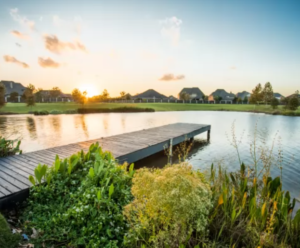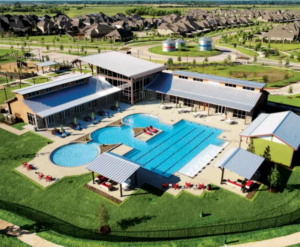Recreational facilities in Municipal Utility Districts (MUDs) and other water districts play an important role in communities. Currently, only 1% of the taxable value of property in these districts may be used to support bonds that pay for recreation facilities. The West Houston Association Parks, Recreation & Open Space Committee is leading the conversation to increase the recreational facilities limit. Recreational facilities provide many health benefits to residents in MUDs and other water districts.
The Blues to Greens Forum: New Ideas in Conservation and Recreation taking place July 23rd will include a discussion about promoting the expansion of recreational facilities through the use of bonds, water conservation, and optimizing open spaces for recreation. Registration is open. For more information about this cause, please read below (courtesy of the Houston Wilderness).
One-Pager on Tx State Laws_Regs for MUDs Recreational Facilities (Feb 2020)

Harvest Green: Lake

Jordan Ranch: Community Garden

Harvest Green: Pool
What are Recreational Facilities in Municipal Utility Districts (MUDs) and other Water Districts?
(A) Forests, greenbelts, open spaces, and native habitat
(B) Sidewalks, trails, paths, boardwalks, and fitness trail equipment (except golf courses)
(C) Pedestrian bridges and underpasses that are less than 200 feet in length
(D) Outdoor ball fields
(E) Parks (outdoor playground facilities and associated ground surface amenities)
(F) Amenity lakes, and associated water features, including splash pads and pump houses
(G) Non-air conditioned recreational buildings (restrooms and storage), outdoor tennis and basketball courts
(H) Fences no higher than eight feet and not associated with residential lots
(I) Landscaping (including, but not limited to, trees, shrubs, and berms) and associated irrigation1
How can MUDs build Recreational Facilities?
MUDs may acquire recreational facilities and obtain funds to develop and maintain them in the same manner as authorized for the acquisition, development, and maintenance of other district facilities.2 Allowing recreational bonds has been very successful and has allowed for hundreds of acres of critical green space!
Where and How can MUDs pay for Recreation Facilities in Texas?
MUDs pay for and finance public infrastructure (such as water, sewer, and drainage facilities and roads) through bonds supported by ad valorem taxes. Likewise, MUDs located in Bastrop, Bexar, Waller, Travis, Williamson, Harris, Galveston, Brazoria, Montgomery (some restrictions apply), or Fort Bend Counties may issue bonds supported by ad valorem taxes to pay for the development and maintenance of recreational facilities only if the bonds are authorized by a majority vote of the voters of the district voting in an election held for that purpose and accessible to the general public of the district.3
Are there restrictions on the bonds that MUDs can issue for Recreational Facilities?
Yes, a MUD’s outstanding bonds supported by ad valorem taxes for recreational facilities may not exceed 1% of the taxable value of property in the district at the time of issuance of the debt.4 This limitation does not apply to the financing of other MUD facilities; only paying for recreational facilities is limited.
___________________________________________
1 Texas Administrative Code, Title 30, Part 1 TCEQ, Chapter 293.41., Subchapter E
2 Texas Water Code (TWC) Sec. 49.464. ACQUISITION OF AND PAYMENT FOR RECREATIONAL FACILITIES.
3 Article XVI, Section 59, Texas Constitution; TWC Sec. 49.4645. DISTRICT IN CERTAIN COUNTIES: BONDS FOR RECREATIONAL FACILITIES.
4 Texas Administrative Code, Title 30, Part 1 TCEQ, Chapter 293.41., Subchapter E
